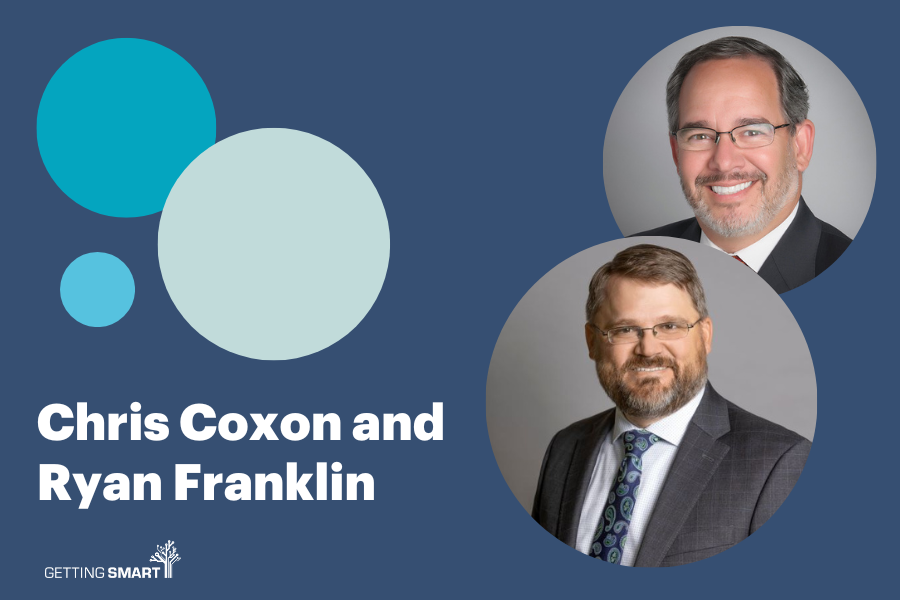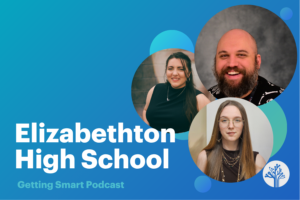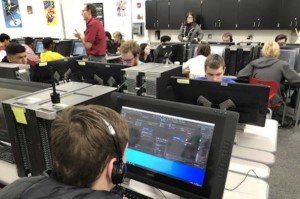Chris Coxon and Ryan Franklin on Educate Texas
Key Points
-
Strategic Partnerships and Legislative Support in Texas Education provide a robust framework and practical insights for successfully implementing educational models.
-
Targeted programs like P-TECH and Early College High Schools can help us bridge educational gaps, equip underrepresented students with meaningful credentials, and prepare them for modern workforce demands.

On this episode of the Getting Smart Podcast, we’re joined by two members of the Communities Foundation of Texas team: Chris Coxon, Managing Director of Programs; and Ryan Franklin, Senior Director, Policy & Advocacy. More specifically, they are a part of Educate Texas, an organization that has been in a leadership role in college and career readiness school models for over two decades and has been the lead intermediary supporting the successful growth of both the Early College High School and P-TECH school models.
P-TECH schools address the current skills gap by equipping students with real-world learning experiences. Investing in P-TECH programs also stimulates local economies by creating intentional talent pipelines and they offer opportunities for increased equity for students from diverse backgrounds.
Additionally, Educate Texas is leading the Texas Accelerate ED cohort, supported by the Bill & Melinda Gates Foundation. Accelerate ED is built on the idea that high schools can provide early access to quality higher education in ways that incorporate work-connected learning and have long-term benefits for students. This initiative helps state-based groups plan and build accelerated pathways between K-12 education, postsecondary education, and careers.
Transcript:
- Overview of Educate Texas and Its Initiatives
- Challenges and Strategies in Policy Implementation
- Funding, Policy, and Sustainability
- Advice and Conclusion
- Links and Guest Bios
Shawnee Caruthers: You’re listening to the Getting Smart Podcast. I’m Shawnee Caruthers. Today, we’re joined by two members of the Communities Foundation of Texas team, Chris Coxson, Managing Director of Programs, and Ryan Franklin, Senior Director, Policy and Advocacy. Educate Texas has been in a leadership role in college and career readiness school models for over two decades and has been the lead intermediary supporting the successful growth of both the Early College High School and P-TECH school models.
P-TECH schools address the current skills gap by equipping students with real-world learning experiences. Investing in P-TECH programs also stimulates local economies by creating intentional talent pipelines and offering opportunities for increased equity for students from diverse backgrounds.
Overview of Educate Texas and Its Initiatives
Educate Texas is leading this Texas Accelerate Ed cohort, supported by the Bill and Melinda Gates Foundation. Accelerate Ed is built on the idea that high schools can provide early access to quality higher education in ways that incorporate work-connected learning and have long-term benefits for students.
This initiative helps state-based programs plan and build accelerated pathways between K-12 education, postsecondary education, and careers. Welcome, guys. So great to have you here with us today. Thank you, Shani. It’s great to be here. I’m so, so excited to learn more about the great things that are happening in Texas.
So let’s start with just learning a little bit more about what Educate Texas is. Chris, we’ll start with you, can you tell us what Educate Texas is, and how it met within the Community Foundation of Texas.
Chris Coxon: You bet. So, we are a statewide initiative of the Community Foundation of Texas. We were established In 2005, as a public-private partnership, that was created to serve as this partner to our state agencies at that time, primarily to deal with what was widely publicized as a number of dropout factories that existed in Texas.
What we were trying to do was, leverage philanthropic dollars to come up with new and different models? Once we created those models and demonstrated their efficacy, we then worked with our public agencies in Texas, here, particularly the Texas education agency, and more recently with the higher coordinating board and the Texas workforce Commission to get codified into state policy.
Incentives and rules and regulations that would help really accelerate and increase that model so that public funding would take over and keep accelerating the work. That’s what our model has been since 2005. We have expanded the areas of focus and I think living, as an initiative within a community foundation has given us a really interesting perspective because we’re able to, As I said, leverage philanthropic dollars to basically do R&D and not waste the state’s public dollars on things and then be able to hopefully scale really promising practices.
Challenges and Strategies in Policy Implementation
Shawnee Caruthers: Yeah, and Chris, you talked about the complication of the work in order to turn it into policy and what that looked like as it related to TEA and other intermediaries. Ryan, I know that work is not easy and it takes some time. What are some of the steps that you all took to get it to where it is today?
Ryan Franklin: Yeah, I think it’s really important to have those local exemplars and models in place so that you can really highlight the potential for state leaders and state policymakers to see what works, what the impact is for students, and where that benefit is really coming from. So I think that’s one of the powerful things about the model that’s set up here, you can have the proof of concept in place, and then you can leverage those stories and data points that arise from local practice to take that to state policymakers to support a statewide systemic investment or incentive baked into the statute and structure to sustain things long-term.
Shawnee Caruthers: Yeah, that storytelling piece is so key, and sometimes often forgotten, especially like the process piece, when we get to the end, we’re like, oh, it’s so great, but how did it start, you know, that’s really where the gems are, so Chris, how did this work get started, or how did you even get started in this work, and then how did Accelerate Ed come into play?
Chris Coxon: You bet, like, I said earlier, we started in 2005, with, developing and modifying a model that had come from the New England area, around early college high school models, there were some middle high models. What we wanted to do was develop a cohort of campuses that were very focused on getting students, the ability to earn 60 college credit hours while they were still in high school.
We also developed a separate track on STEM academies. We knew that a lot of the careers that were coming into the state would require many of the skills that were focused on STEM and so we built other models there. I think in both of these models, what we saw was that if we really wanted to serve, the student population who was typically not represented in higher education. We needed to give them not just enough help to get, over the bar, but we needed to put them at a much higher level by giving them college credit and a college degree.
Shawnee Caruthers: Yeah, and I appreciate you really surfacing, when you were talking about those who are furthest from opportunity and how your program is set up to ensure equity amongst all of those groups.
Ryan, I’m sure there have to be some strong policy or advocacy efforts in place in order to create a model that supports that sort of equity framework. What are some of the things that you have worked on to make that happen?
Ryan Franklin: Again, going back to the proof points and showing what works is a great place to be operating from.
What we’ve seen with the College Preparatory School models is they are proving their worth in getting students to that. point. the focus, on much higher rates of students achieving 50 or more hours of dual credit courses, is significant.
in a state as diverse as Texas, in every sense of the word, having those proof points and those, elements built in really enables this to have broad appeal.
Being able to show, hey, this works in your region, in your school context. And to have a broad base of support among legislators, by having those proof points in contexts like theirs or in their own context is really important in ensuring this is available for all students. It’s a case where the programmatic work reinforces the policy work and where you’re able to incentivize outcomes and build in.
The state has over time put in college career and military readiness outcomes bonuses where there is greater weight put on those community needs, with higher levels of poverty and greater disadvantage. Having those sorts of frameworks in place is really important.
Shawnee Caruthers: So what does it look like to conduct a needs assessment for P-TECH sites and what needs are often surfaced when you’re doing that at different schools?
Chris Coxon: Texas is very interesting in that, all of the P-TECH and early college high schools, in the state actually have to apply for designation to the state agency, the Texas Education. Agency, every single year there is a blueprint that has been created, for both models, which highlights the components of the model.
One of those components is the student population that you’re going to target and how it is representative of your school district in every way. In terms of the P-TECH, it really makes you look at labor data and understand what The labor market needs in your community are, so that if you’re going to implement a program around a particular career focus, you have industry partners in your area who are looking to partner with you, providing work-based learning opportunities for your students so they can really develop the skills necessary to move into that type of career pathway.
For us, one of the important factors is that in a state as large as ours, there are literally thousands of different career pathways. We have said that we are going to focus on developing the resources and models in a few career pathways that we really feel are first and foremost, those that we would be happy with our own children participating in.
We have identified four models, in, teaching. IT and advanced manufacturing and in healthcare, which is the number one area of need in every region of our state, in all of these areas, we help provide resources and supports, and schools can use our templates and models to plug and play other types of career pathways into that
Shawnee Caruthers: It makes me realize the level of support it feels like Texas provides all of its different sites to be able to Implement, these different models in a personalized way.
I don’t want to ask a leading question but Texas as a state continues to be a leader in providing and starting numerous P-TECHs and pathways, as Chris just mentioned. Why is that?
Ryan Franklin: Both the legislature and the state agency leadership—and governor’s offices historically—have really gotten this imperative for an educated workforce.
Ensuring that those opportunities are there to support the high-wage, high-demand jobs and the need to invest in that. has been crucial. Very early on, Texas adopted a policy of ensuring that every, Public school in the state would provide students with the opportunity to earn at least 12 hours of dual credit.
So no matter how small, or rural you are, that is a requirement. and an expectation across the board. Over time, the legislature has made investments in supporting the technical assistance needed to launch and support those campuses and get them off the ground. Additionally, with P-TECH, there’s a 50 per student allotment for every student enrolled in the P-TECH academy to provide additional support.
When we look at the outcome side, there is an outcomes bonus for every student who achieves that college readiness designation and earns the credential or enrolls directly in higher education upon graduation. There are different weights and recognitions in that outcome bonus. So there is both front-end funding to support the launch of these programs, and back-end funding to support the maintenance of this over the longer term.
Furthermore, there are other policy choices that have been made in terms of the funding structure for dual credit courses that really help create the condition to alleviate some of the burden off students The state has made even greater opportunities for students in this last legislative session with what’s called the FAST program.
For the first time in 50 years, Texas Redesigned its community college funding structure and included strong financial aid for dual credit students in the state to ensure that students from disadvantaged backgrounds can achieve dual credit at no cost to them wherever they live.
Chris Coxon: There is a strong commitment at our state agencies and that commitment exemplifies itself in their on-the-ground work with us I think that has been one of the reasons Why this has been as successful as it has. I would say the same for even non-governmental agencies such as the Texas Association of Community Colleges, which is a membership organization working closely with the legislature to help pass the legislation that Ryan shared a bit about and is now helping districts think through. What they need to do differently with their models? They are providing funding to help community colleges.
rethink their role in this work. Our model from the very beginning has been focused on a high school interested in this type of programming, going to their community college partner, and a business and industry partner and saying, I want you to partner with me around this type of model.
What we’re trying to see now is if there’s a way to balance that model better and have, funding and resources that support the community college in restructuring their data systems, and student support systems to handle an increasing number of students in these models.
Ryan Franklin: I might add that we also are a state with a strong Network of backbones in a state with just the sheer square miles we have to cover, there are a lot of folks working in different regions to support this kind of thinking and work. I think we’re fortunate to support this work around the state, but we know there are local partners and intermediaries invested in the work, ensuring that students in their regions have these opportunities.
Shawnee Caruthers: Part of what you both shared, is that in this work, it involves advocating for the addition of policy and funding structures because in order to do this work, you must ensure it’s sustainable you’re integrating the necessary voices in program design implementation, redefining sector partners and guaranteeing expanded academic and navigational support during different transition years. I would love to just walk through some of that and discuss what are some things that you felt stood out or really, helped with those enabling conditions for others who might be thinking about what this can look like in their system.
Let’s start first with funding policy and sustainability.
Funding, Policy, and Sustainability
Ryan Franklin: It starts with the fact that for dual credit both the public school and the community college receive funding for that enrollment as a baseline, and that support helps take some of the risk out of that then you layer on additional funding for P-TECH from the state and you layer on additional outcomes-based funding for both the K-12 partners and the higher education partners.
So you have resources in place that allow local contexts to bring together funding in thoughtful intentional ways to make it stronger. It’s not just dependent on one funding stream, or one grant program, or one initiative, but it’s integrated and combined in a way to have more comprehensive resources that aren’t dependent on one political initiative one moment or one leader’s initiative.
This is built into our funding formulas and our structures for both public and higher education.
Chris Coxon: That point of both entities getting funding, is a big one as I know in other states that isn’t always the case. I will say we have had before. Brand new legislators who have been elected and come and have said, Aha, I caught you all you’re double dipping, and, we’re like, yes, you caught us for every dollar you’re putting in. We’re giving you seven, or more back in terms of outcomes and everything. What we have been fortunate to partner with national entities like jobs for the future and others who have worked closely with the state agency in the development of these blueprints. As I said, these are all public documents. that We share with other States who are interested in seeing them and everything, There’s a roadmap of how to, Establish this program and what are the necessary components to have in place for it to be successful?
Ryan mentioned earlier. that we have tied outcomes bonus measures to those parts if you’re bringing in the types of students you’re supposed to be and they are getting the outcomes they’re supposed to be and you are checking all those boxes in terms of support, then you will get more dollars But you need to show you’ve done it, right?
And that the outcomes are there for the students as big a state as we are one of the things that is always nice to see is you have a very open and willing community to share ideas and resources. we have 1,200 school districts in our state and, we are working, with only about 20 percent of those districts as a whole.
But they are always sharing resources, capacity building. And ideas with one another. while they will be competitive on Friday night football, they are very much into sharing and resource supports for one another. One of the areas that recently passed which I think exemplifies this is support for some of the small and rural communities.
Texas has the largest rural population in the nation. And recognizing that some of these small schools and rural communities can’t be everything to everybody. There has been new legislation put in place to specifically support rural communities, forming consortiums to support these career pathways.
Shawnee Caruthers: What about program design? Does that vary across different communities or is it pretty much the same?
Chris Coxon: There are some non-negotiables in terms of what the work looks like and everything. What we have found in our communities, is that people have been very innovative, even prior to the pandemic, a lot of these small and rural communities that don’t necessarily have a higher ed institution nearby have had to use online dual credit opportunities and things like that.
Obviously, Everybody became very knowledgeable about how to do that during the pandemic, we have leveraged partnerships like that, and new innovations to do it, if you walk into an early college high school or, P-TECH anywhere in the state, it’s going to have some common components, that each of them follows.
Shawnee Caruthers: As you think about those common components, and as you think about, your measures of impact and, effectiveness in general and the quality of these programs, Ryan, I’ll jump to you, how do you ensure the quality of these programs, and what does quality even look like?
Ryan Franklin: Ultimately quality is about the impact on students and their futures. one of the things that was embedded within this community college finance bill that passed last year was essentially the credential value and really looking back on, is this credential adding value to that student’s life?
We’re still very much in the nitty-gritty work of defining that and looking back at how to calculate and articulate that. So I think that’s ultimately an outcome measure. As we look at the work we’re examining if students are graduating College and career-ready. Are they graduating?
With a meaningful credential that they earned while in high school? Are they directly enrolling in college to continue their education if necessary? Those are some of the outcome measures we’re looking at ultimately I think this credential value indicator calculation Will help be an important tool in doing this.
Chris Coxon: I would add that if you look at Statewide completion of a degree it is 14 percent. for the population of students we are trying to serve, it’s important that they complete something and that the credential becomes the first in a series of stackable credentials that lead to either a level one or level two certificate, an associate’s degree or a baccalaureate degree.
In our early college and P-TECH, well over 50 percent of the students are graduating with a degree or credential compared to the 14 percent for the general population in regular high schools.
Shawnee Carruthers: I know you all are working specifically with—or have at least worked with—a partnership, to Accelerate ED, to increase more postsecondary enrollment. At Bexar County High Schools, as those graduates go to a degree or credential program, you all are looking to at least increase that by, around 70 percent by 2030. How do you plan to do this?
Chris Coxon: The UP partnership, which is one of the backbones like that Ryan talked about before, is an innovative partnership that is really doing an incredible job of bringing together the community and their sub motto, have. It is an acronym which stands for healing, access, voice, and equity.
And so that’s their model around the work. And they have been very successful in bringing the community together and trying to raise up models that are going to be successful.
Advice and Conclusion
Shawnee Caruthers: I guess lastly, as you think about any advice to policymakers about the importance of and the need for the expansion of dual credit and workplace learning opportunities, what advice do you have?
Ryan, I’ll start with you. Is it more offerings? Is it a policy? Is it something totally different?
Ryan Franklin: I think alignment around expectations and resource allocation is really important. So often things come out. We always talk about our silos in education. And so often things are done either through funding or through policy initiatives in a siloed way.
So I think anything policymakers can do to foster aligned investments, aligned expectations. I think that helps communicate more clearly to the field because students don’t care about these artificial boundaries that bureaucracy sets up. The students want a smooth, efficient system to get through.
I think where there are opportunities for policymakers to align on definitions, align on expectations, align on incentives, I think that’s, that’s really important and to foster that alignment, not create artificial barriers. I think that’s fairly broad and overarching, but I think it’s really important.
It’s easy, to overlook in the course of setting some of these structures up.
Shawnee Caruthers: Students deserve all of those things. Thank you. Chris, what about you?
Chris Coxon: So I think I’ll just take it from a, from a programmatic standpoint. I think I would love to see more educational leaders.
Demonstrate the courage to set up programs either similar to this or others. There may be some innovations that they’re creating. I think too often we see the imbalance and inequity that exists in our educational systems and feel like, Oh, there’s nothing that can be done. And we like complaining about it a lot.
And I would just love to see people doing more about it in very concrete ways. Schools have the opportunity to truly live up to the grand goal of it being the center of our democracy. I look forward to schools being able to do that and communities doing that. It doesn’t mean that it’s not extremely challenging to do, but we have seen some incredible leaders who have focused.
Their resources and their times and develop a vision that helps the kids that we know need it and that our community needs to have make it be successful and so I just encourage them to do the same
Shawnee Caruthers: Yeah, and I appreciate you all both sharing the great things that are happening down in texas It’s this probably aligns to a call that I had earlier about do you want to transform a system?
Or do you want to like reform it? It’s not like you are just going to just like blowing it up and just starting, you know Starting from scratch, to do what’s best for students Like you said to make them really productive citizens and give them every single opportunity So thank you for sharing and allowing us just a little peek into what’s going on in texas and all of the things that others can do to maybe even replicate some of these strategies in their own region. Thank you both for being here with us today.
J. Chris Coxon
Managing Director, Educate Texas
Chris is the managing director of programs for Educate Texas, supporting a team working to improve educational outcomes for low-income, minority and first-generation students across the state.
This work focuses on four key areas: developing and scaling college and career readiness school models; improving the talent pipeline of teachers and school leaders; promoting access and completion of a degree or credential with labor market value; and developing the civic infrastructure for communities to accelerate academic achievement for all.
Prior to coming to CFT, Chris held a number of educational leadership positions including teacher, teacher leader, district administrator and principal. Before moving back to Dallas, he was the chief academic officer of the Boston Public Schools for five years. During his tenure, the district was designated by the Broad Foundation as one of the top five urban school districts in the nation for improving academic gains for all students and decreasing achievement gaps.
Chris holds a bachelor’s in biology from Benedictine College and and a master’s in education with a focus on administration, planning and social policy from the Harvard University Graduate School of Education.
Ryan Franklin
Senior Director of Policy and Advocacy
As the senior director of policy and advocacy, Ryan leads the policy and advocacy strategy for K12 and higher education at Educate Texas.
Prior to joining CFT, Ryan was the associate commissioner for educator leadership and quality at the Texas Education Agency, where he led a team focused on educator preparation, certification and testing as well as investigations and enforcement for educator misconduct. Prior to that, he was a policy adviser for former commissioners of education Michael Williams and Robert Scott. Ryan also worked for the Texas Senate Committee on Education, where he focused on college and career readiness, public school assessment and accountability, special education, career and technical education, school safety and educator quality.
Ryan taught English in Covington and Valley Mills ISDs in Central Texas. He is a first-generation college graduate and seventh-generation Texan.
He holds a bachelor’s degree in English from West Texas A&M University and a master’s degree in public policy and administration from Baylor University.
Links








0 Comments
Leave a Comment
Your email address will not be published. All fields are required.